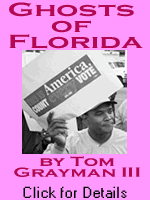
|
|||||||||||||||||||||
 |
|||||||||||||||||||||
 |
|||||||||||||||||||||
 |
We at BlackCommentator.com are very impressed with the work done by the dedicated educators and activists of the Teaching for Change and Poverty and Race Research Action Council, based in Washington, DC. They remind us that we do, indeed, have activists in the field. Too often, the teaching of the Civil Rights Movement – as a spontaneous eruption of angry but saintly African Americans led by a few inspired orators – discounts the origins, the intellect and the breadth that guided this complex social movement. Rather, strategic brilliance, logistical messiness, exalted joy, heart-gouging sorrow, unbelievable courage, sharp tactical conflicts and near-religious personal transformations are all part of the very human story of ending formal racial segregation in the United States. In addition, the civil rights story tends to focus exclusively on the Black freedom struggle, ignoring the struggles of all people for justice, in the US and internationally. Teachers also face practical challenges in
presenting the full story. The bookends of the modern Civil Rights Movement are often
marked with the 1954 Supreme Court decision
A proper telling of the story of the Civil Rights Movement includes the themes of education and economic justice. Despite the many lawsuits related to school desegregation and equity, little attention is paid to the social purpose of education – that is, creating a place where youth can achieve excellence, prepare for leadership, gain a critical analysis of power, and learn to uphold many cultures. Winning economic justice is a parallel narrative to securing political power. In fact, many Northern and Southern activists during the Civil Rights Movement learned organizing skills through earlier work with labor unions. In addition to these themes, a better approach to teaching the Civil Rights Movement uncovers and humanizes the stories of the many ordinary people who did heroic things. Such an approach enables students to learn useful lessons about their role in the world, to develop strategies to address pressing problems in their lives and community, and to see themselves as agents of change. Lenses for Viewing the Civil Rights Movement Ideally, the story should be viewed through several lenses – youth, women, organizing, culture, institutionalized racism, and the interconnectedness of social movements – which offer metaphorical magnifying glasses for understanding the Movement. Youth. Economic and social forces over the course of the
20th century reduced the public role of youth to little
more than consumers. With compulsory schooling laws and laws against
exploitive child labor, youth were encouraged to pursue schooling
rather than compete with adults in the employment market. Economic
shifts created a loss of unskilled jobs, making formal education
a greater necessity
Women. Through organized religion, conventional wisdom, and the law, women have often been discouraged (if not banned) from participation in public debate and from holding leadership outside of female-only groups. Nevertheless, women have voiced public opinion and exercised leadership from the earliest days of European encounter, slavery and abolition, various wars, women’s suffrage, and women’s liberation movements. In the Civil Rights Movement, women’s definitions of their own leadership worked with and against the strategies for change expressed by African-American and white men. Students need to see the distinctive “women’s” ways of shaping social change movements. Organizing. The celebrity media culture became even more pervasive with the widening popularity of television in the 1950s and 1960s. The coincidental timing with the Civil Rights Movement was both a blessing and a curse. On the one hand, people worldwide witnessed the unedited brutality of white supremacy and helped put pressure on policymakers for change. However, mass media also glamorized the product (the marches, the rallies, the arrests, etc.) at the expense of the long, sometimes boring, and always difficult process of organizing people to change their attitudes, behaviors, votes, and spending habits. The creation of media stars robs power from the collective efforts of the many hard-working people who comprise social movements, even though it may be easier to teach about charismatic individuals. Students need to learn the mistakes, the second-guessing, and the conflicts among planners and activists. Through the organizing lens teachers can share the complex tactics and strategies that lie behind the observable movements for change and the range of talents and personalities required to achieve success. Such education is an essential part of learning to be active participants in a democracy. Culture. Enduring movements for social change transform the landscape of people’s daily lives, or their culture. Culture defines what (and who) is beautiful, funny, worthy of praise, nourishing, comforting, and the source of our strength. Music, visual images, language, clothing/hair, religion, and leadership styles are the arenas of the most apparent transformations. The interracial and cross-generational nature of the Civil Rights Movement created new symbols and new uses for culture as a way to attract “converts.” Many of these cultural shifts also influenced other social movements. Through the lens of culture, students learn how familiar culture (such as songs and call-and-response oratory) was used as an organizing tool, how cultural expressions were central rather than peripheral to building a community of activists, and how the political and economic choices made by organizers and activists were rooted in their daily lives, foods, songs, and worship.
Institutionalized racism. In the United
States, institutionalized racism promotes the ideology that:
(1) there are separate races
among humans; (2) that the “white race” is superior; and (3) that
this supremacy must be reinforced (violently, if Interconnectedness. Finally, as inspiring as is the story of the Civil Rights Movement, it is interconnected to the historical and ongoing human call for justice worldwide. In the 20th century alone, Civil Rights Movement activists were connected with the anti-lynching movement, Spanish civil war resistance, the labor movement, tenant farmer organizing, Roosevelt’s New Deal, India’s independence, the desegregation of U.S. military forces, African liberation, the American Indian Movement, the Chicano movement, the Asian Pacific Islander movement, the farmworkers’ movement, the women’s movement, the anti-war movement, the Free South Africa movement, the Solidarity movement, liberation theology, the sanctuary movement, gay liberation, the environmental justice, and, even, some would argue, the tactics used in the anti-abortion and religious fundamentalist movements. Teachers need to show the ways in which many people within the various social justice movements were directly inspired by one another and felt connections beyond their own racial identities and national borders. James Baldwin reminded us in his “Talk to Teachers” that “in the attempt to correct so many generations of bad faith and cruelty,” teachers and parents will face brutal and determined resistance. The teaching and learning of this complex history is an active, not a passive, process that should be supported by comprehensive materials. These tasks – resisting the pat story (in this case, of the Civil Rights Movement), being energetic and visionary in the telling, and seeking supplemental information – are the essentials of excellent teaching. To convey Civil Rights Movement history in this way helps teachers be the “midwives” for this generation as it does what Grace Lee Boggs says each one must—“discovers its mission” for creating a more just, caring, beloved community. Jenice L. View is coeditor of Putting the Movement Back into Civil Rights Teaching and its companion website, www.civilrightsteaching.org. When she isn’t teaching eighth-graders, Ms. View is executive director of Just Transition Alliance, an economic and environmental justice nonprofit organization in her native Washington, DC. |
| January 27 2005 Issue 123 |
|||||||||
|
|||||||||
|
|
|||||||||
| Printer Friendly Version | |||||||||
 |
|||||||||
 |
|||||||||
 |
|||||||||
| |
|||||||||
| |
|||||||||



























